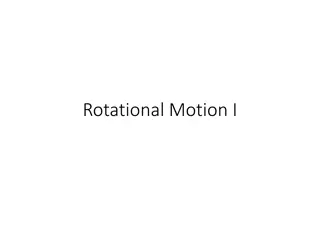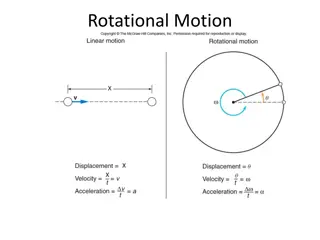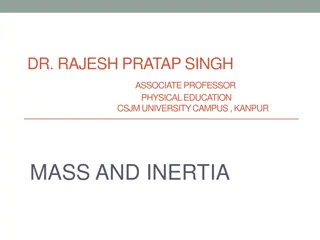Understanding Torque and Rotational Inertia in Rigid Bodies
In the realm of rigid bodies, the application of force at specific points is crucial for inducing rotation. Torque, denoted by the Greek letter tau, is the product of the force and the lever arm length, determining the rotational effect. By grasping the concept of torque and its applications, one can comprehend how forces create rotational motion in objects. Examples, such as torque wrenches and bolt tightening scenarios, illustrate the relevance and practicality of torque in everyday contexts.
Download Presentation

Please find below an Image/Link to download the presentation.
The content on the website is provided AS IS for your information and personal use only. It may not be sold, licensed, or shared on other websites without obtaining consent from the author. Download presentation by click this link. If you encounter any issues during the download, it is possible that the publisher has removed the file from their server.
E N D
Presentation Transcript
L-10(M-9) torque and rotational inertia We consider the rotation of rigid bodies. A rigid body is an extended object in which the mass is distributed spatially. Where should a force be applied to make it rotate (spin)? The same force applied at different locations produces different results. AXLE 1
TORQUE Greek letter tau To make an object rotate, a force must be applied in the right place. the combination of force and point of application is called TORQUE The lever arm L is the distance from the axis of rotation to the point where the force is applied If the line of action of F passes through the axis of rotation, it produces no torque. lever arm: L Axis Force, F 2
Torque: (Greek tau) Torque = force (F) x lever arm (L) = F L force F in Newtons, N lever arm L in meters, m Torque in units of N m 3
Torque example What is the torque on a bolt applied with a wrench that has a lever arm: L= 20 cm with a force: F = 30 N? F Solution: = F L = 30 N (1/5) m = 6 N m L For the same force, you get more torque with a bigger wrench the job is easier! 4
Torque wrench A torque wrench is a wrench that applies a calibrated torque to a bolt. It prevents a bolt from being over-tightened and possibly breaking. 5
Homer attempts to straighten out the leaning tower of Pisa lever fulcrum 6
Net Force = 0 , Net Torque 0 10 N 10 N > The net force = 0, since the forces are applied in opposite directions so it will not accelerate. > However, together these forces will make the rod rotate in the clockwise direction. 7
Net torque = 0, net force 0 The rod will accelerate upward under these two forces, but will not rotate. 8
Balancing torques 20 N 10 N 0.5 m 1 m Left torque = 10 N x 1 m = 10 n m Right torque = 20 N x 0.5 m = 10 N m 9
Equilibrium To ensure that an object does not accelerate or rotate two conditions must be met: net force = 0 net torque = 0 this results in the practical 4-1 ladder rule 10
When is an object stable? If you can tip it over a bit and it doesn t fall The object may wobble a bit but it eventually stops and settles down to its upright position. A thinner object is easier to topple An object that is thicker at its base is more stable 11
Why do tall objects tend to fall over Every object has a special point called the center of gravity (CG). The CG is usually in the center of the object. if the center of gravity is supported, the object will not fall over. The lower the CG the more stable an object is. stable not easy to knock over! 12
Condition for stability If the CG is above the edge of the table, the object will not fall off. CG 13
Why makes an object tip over? CG CG STABLE UNSTABLE D D For the wide object, the dashed line extending from the CG down is to the left of the point of contact; the torque due to the weight tends to rotate the object counterclockwise For the narrow object, the dashed line extending from the CG down is to the right of the point of contact, the torque due to the weight tends to rotate the object clockwise. 14
Stable structures Structures are wider at their base to lower their center of gravity 15
Playing with blocks CG If the center of gravity is supported, the blocks do not fall over 16
Coin Stack 17
High Profile Vehicles wind As more stuff is loaded into a semi, its center of gravity moves upward, making it susceptible to tipping over in high winds. 18
Rotational Inertia (moment of inertia) symbol I A rigid body is characterized by a parameter called its rotational inertia The rotational inertia of a RB depends on how its mass is distributed relative to the axis of rotation The rotational inertia of a RB is the parameter that is analogous to inertia (mass) for a non- extended object For a RB, the rotational inertia determines how much torque is needed to produce a certain amount of rotational acceleration (spin). 19
rotational inertia examples Rods of equal mass m and length L axis through end axis through center I = 4 I end center The rod with the axis through the end requires more torque to get it rotating. 20
How fast does it spin? For spinning or rotational motion, the rotational inertia of an object plays the same role as ordinary mass for simple motion For a given amount of torque applied to an object, its rotational inertia determines its rotational acceleration the smaller the rotational inertia, the bigger the rotational acceleration 21
Same torque, different rotational inertia = =F L = mgR L = R Small rotational inertia Big rotational inertia spins slow spins fast F = mg 22























